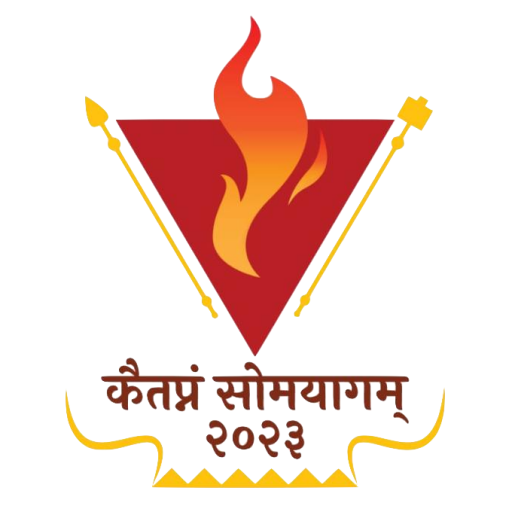Yajnas are performed in different ways according to the need, the occasion, the preferences and desires of the worshippers. A typical yajna is performed after choosing a clean place, which shall be free from impurities and evil influences, and after ascertaining an auspicious time as determined by a priest who is well-versed in the subtle nuances of Hindu calendar. A typical Yajna is an elaborate mechanism with many moving parts like the parts in a wheel. It may have all or some of the following parts or components (yajna-anga).
- Yajnastala or Yajnabhumi: The sacrificial place
- Yajnavatika or Yajnashala: Sacrificial hall, shed or enclosure
- Yajnakundam: The sacrificial pit
- Yajnavedi: The sacrificial altar which is usually made of bricks according to specifications
- Yajnadiksha: Formal declaration to perform the yajna
- Yagagni: The consecrated sacrificial fire, which is either specially prepared or taken from domestic fires
- Yajnadravyam: Sacrificial materials or offerings
- Yajnapasu: The sacrificial animal
- Yajnakila: The sacrificial post to which the animal is tied
- Yajamana: The host of the sacrifice.
- Purohita: The chief priest.
- Brahman: The supervising priest
- Devas: The gods for whom sacrifice is performed
- Yajna-amsam: The share which is due to each god in a sacrifice
- Yajnasesha: The remains of the sacrifice
- Yajnasadas: The assembly of men who attend the sacrifice
- Yajnasiddhi or Yajnaphalam: The outcome or the fruit of a sacrifice
- Bhokta: The enjoyer of the sacrifice.
- Bhakta: The offering
- Agnihotri: The Brahmana who keeps sacrificial fire.
The Vedic Yajnas have to be performed strictly according to procedure. Procedural purity is important to ensure that the Yajna produces the intended results. The purity of the participants, chants and the materials used in the sacrifice is also equally important. Some Yajnas may last for a few hours or for days and months and require special preparation. Some are performed in private and some in public. They are also performed individually or collectively according to the need. A typical yajna has a preparatory part, an introductory part, a middle part and a concluding part. In each stage, the same priests may perform various duties and chant different mantras, or it may be done by different classes of priests who have specialized in them. They do so to propitiate the gods, prepare the sacrificial place, ward off evil powers, invite the gods to the ritual place or convey the desires, intent and purpose of the sacrifice. At the end of the ceremony, priests perform expiatory rituals to safeguard the purity and sanctity of the rituals. Some Yajnas may require the performance of related Yajnas either immediately or after a gap for their successful completion
